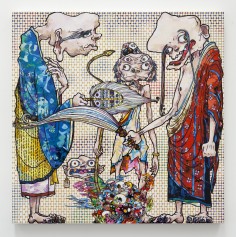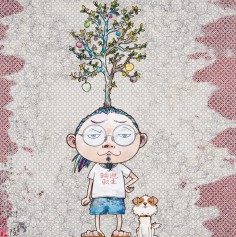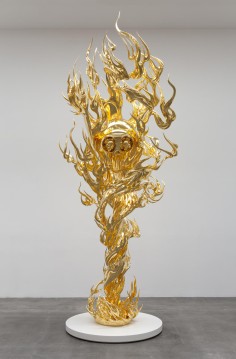
Artist plays mind games with viewers
Takashi Murakami's incredibly detailed and wacky paintings are the doors to his imagination, writes Kavita Daswani
Dominating one of the spacious white-walled galleries at Blum & Poe in Los Angeles is a towering, glittering, gold sculpture: swirling flames emanate from a vast skull, the cavernous eye sockets occupied by smaller skulls, the whole effect like that of a gilded alien cadaver in a hurricane.
This is the world distilled through the mind of Takashi Murakami, the 51-year-old Japanese artist whose works sell for tens of millions of dollars, and who is among Japan's most acclaimed modern artists. A fan of , he has woven brightly coloured and often bizarre graphics into his trademark aesthetic, producing sculptures and paintings of stunning depth and range. He sits at the crossroads of a multitude of visual art forms, from sculptures to paintings, fashion, film and installations: his take on them is always striking, colourful, exuberant, startling and versatile.
All those elements are certainly in evidence at Blum & Poe, which has previously opened its halls to exhibitions by the Shanghai/New York-based Zhang Huan and the Berlin-based Matt Saunders.
Murakami's "Arhat", which runs until May 25, is his sixth solo exhibition with Blum & Poe, and his first significant showing in the US since a travelling event some years ago. (He's not been idle: in the past few years, his works have gone from the Gagosian in London and Rome to the Palace of Versailles in France, to the ARKI gallery in Taipei, and the Guggenheim in Bilbao.)
That is the challenge from Murakami, who only seems to ask his audience to feel something - astonishment, fear, contemplation … His work begs to be stared at, rather than cursorily taken in
Murakami created new works for "Arhat", a Sanskrit word that translates as "a being who has achieved a state of enlightenment". It's understandable - initially anyway - to be oblivious to the connection between an elevated spiritual state and some of the hard-edged, almost sinister elements in the artworks presented here.
But that is the challenge from Murakami, who only seems to ask his audience to feel something - astonishment, fear, contemplation … His work begs to be stared at, rather than cursorily taken in.

Interestingly, "Arhat" coincides with the debut, at the Los Angeles County Museum of Art, of his film - a work that combines live action with CGI animation, which he was moved to make after the 2011 tsunami in his homeland. The plot is typical Murakami surrealism: in a mysterious town children fight remote-controlled pets (one with eyes like a jellyfish, hence the title).
The horrors of that natural disaster undoubtedly also provided some of the framework for "Arhat". The show offers a glimpse into the enigmatic mind of Murakami, and showcases his infinitely creative process. The larger paintings measure between 5 metres and 10 metres in length, each millimetre of space occupied by something striking, a visual feast so heaped you don't know where to look first. There are flowers in eye-popping pink and turquoise, wizened old men and Buddhist monks brandishing strings of prayer beads and rough-hewn walking sticks. The details are rich and complete, every crease, every wrinkle, is deftly incorporated into the visual landscape.

A second room in the gallery features a series of smaller paintings, 1.8 metres by 1.5 metres, which at first glance appear full of joy, with chains of happy blue daisies. But peer closer, and the skulls are there again, smaller, lurking here and there, peeking out from behind fresh, pretty petals. Here, Murakami shows off his signature style, fusing his handmade and silkscreen techniques. And in the midst of all this is the artist's first sculpture that is wall-mounted, a silver jagged-edge configuration of skulls.
Despite the existential angst, there is something in the tone of the exhibition that shows Murakami does not take himself too seriously. His third sculpture is a self-portrait: stainless steel buffed to a high gloss, the 1.2-metre-long piece shows him lying on a raised platform on the floor, next to a sculpture of his dog, bifocals perched on his nose, his ponytail tucked neatly behind him, the whiskers of his goatee etched onto his steel face.

The "Arhat" collection will probably redeem the artist in the eyes of those art buffs who were aghast at his (hugely successful) collaboration with Louis Vuitton, where he enlivened that brown-and-beige monogram with his signature flourish using colour and quirky motifs.
Music videos for Kanye West, for whom he also designed album artwork, and other commercial collaborations have made Murakami one of the rare visual artists to have successfully straddled the line between art and commerce, exclusivity and mass appeal.
With "Arhat" Murakami shows conclusively that he has yet to run out of ideas.

